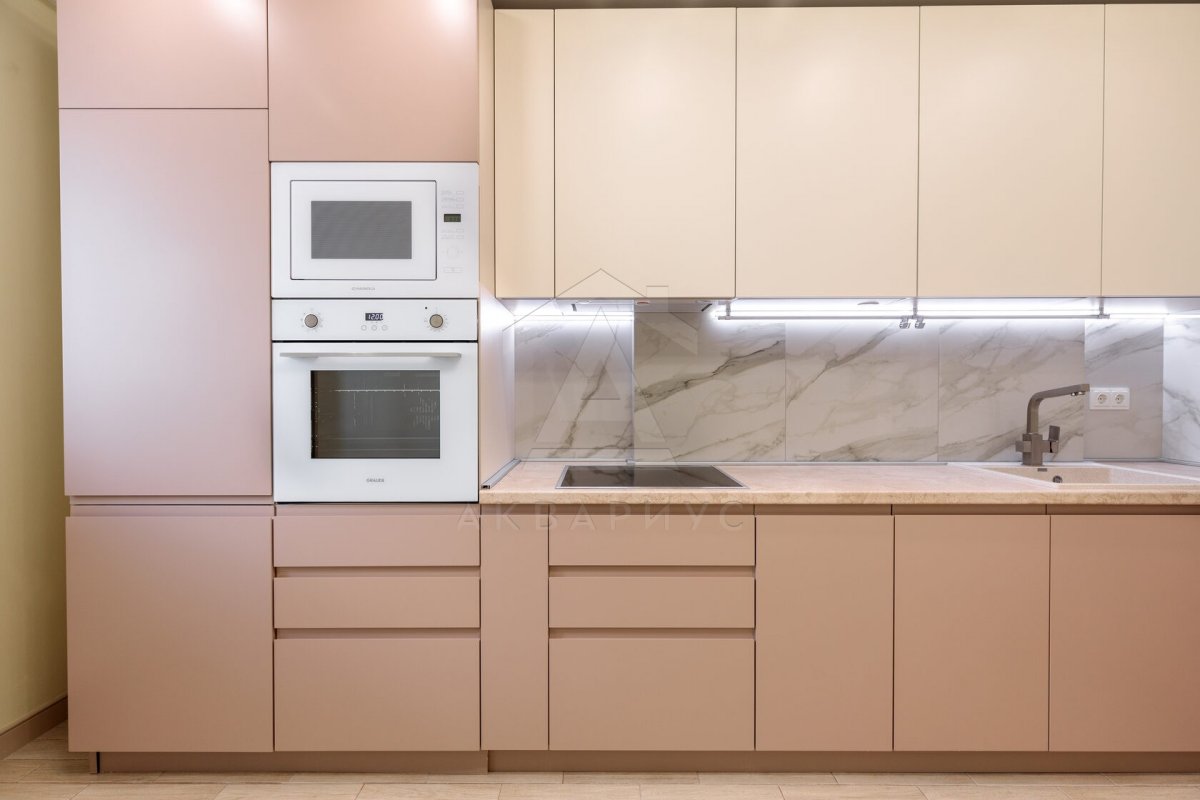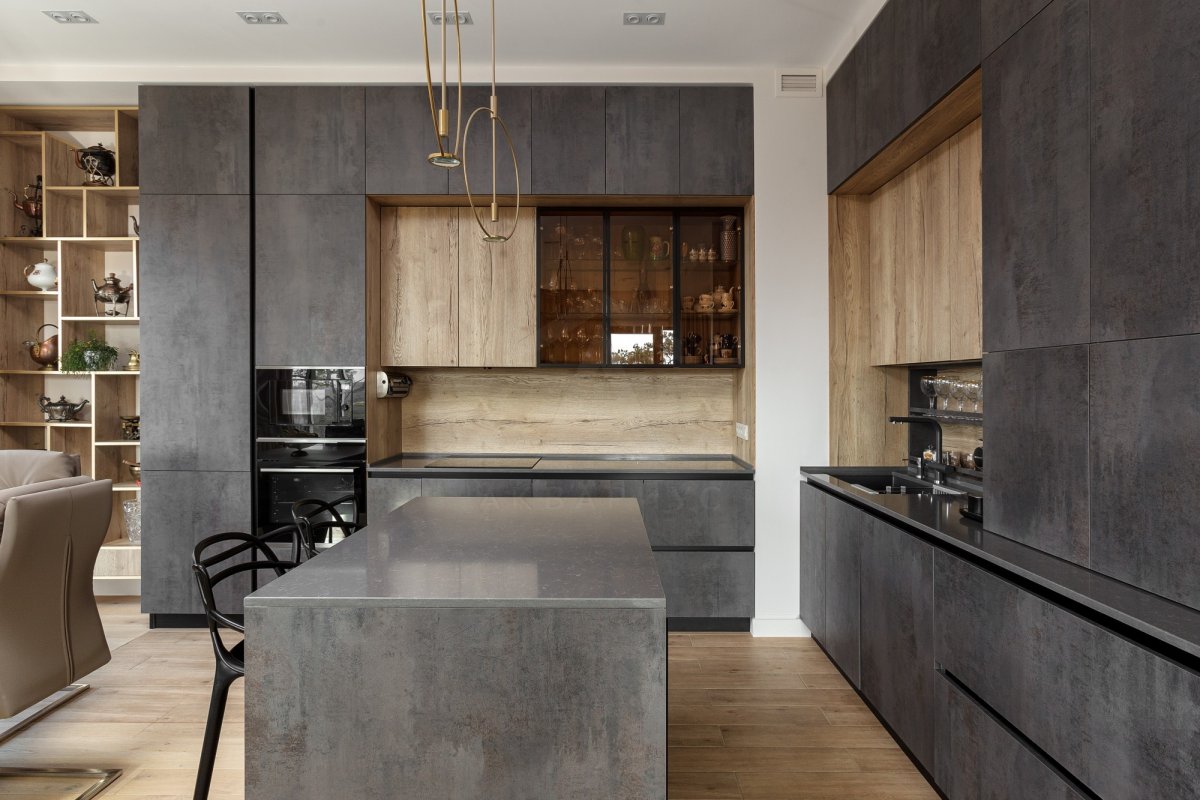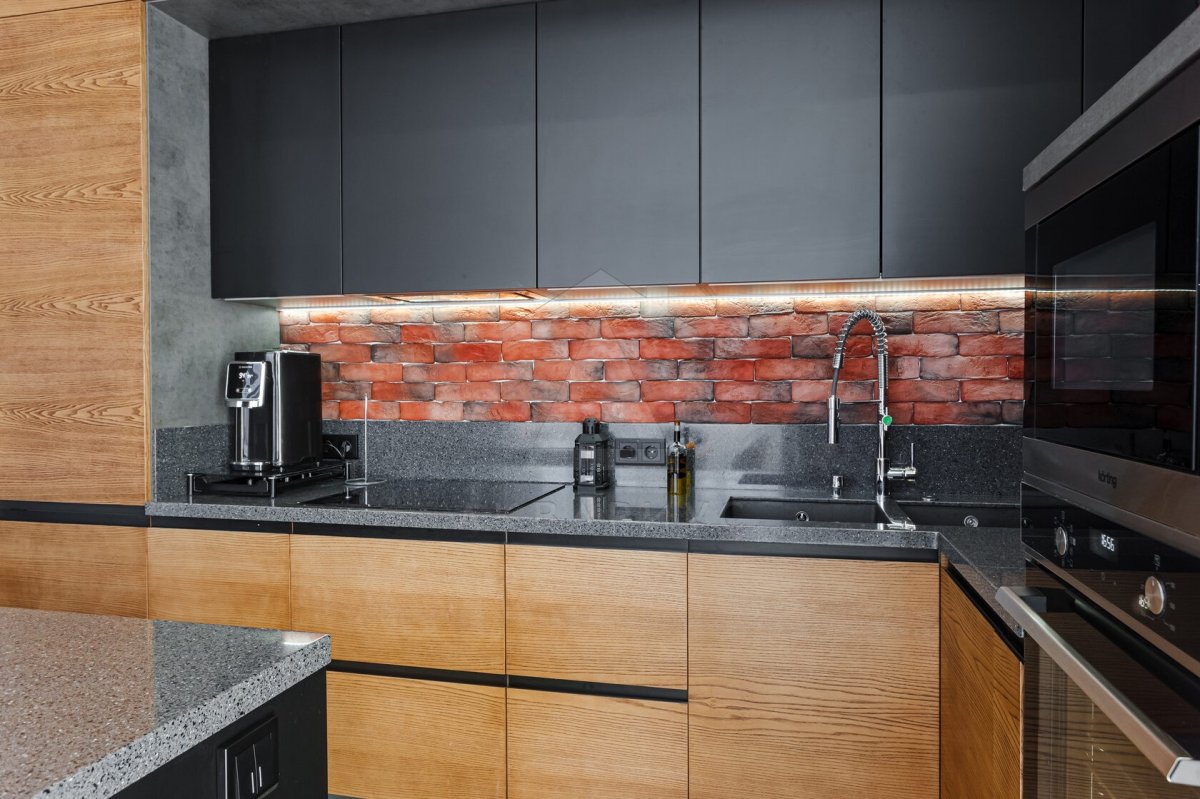A perfectly decorated joint between a apron and a countertop is a key to the durability of your kitchen. Dirt and moisture will not be able to penetrate into the cracks, and the appearance of the working area will be impeccable. In this article, we will consider various ways to design the junction.
Content:
- Triangular plastic plinth
- Aluminum skirting board
- Wooden skirting board
- Low skirting boat made of the same material as the countertop
- High skirting boat made of the same material as the countertop
- Reference tape
- Grout
- Sealant
Method number 1. Triangular plastic skirting
For a long time, a triangular baseboard was the most common option, performing several functions at once. He securely closed the joint between the apron and the countertop, defended the moisture and played a decorative role. Also among its advantages are simple installation, resistance to mold and the ability to hide a rather large gap (up to 3 cm).
However, now the triangular baseboard is gradually gone into the past. It does not always fit into modern interior styles, such as minimalism or high-tech. Designers are increasingly preferring more aesthetic and concise solutions.
Method No. 2. Aluminum skirting
Aluminum skirting boards for countertops are a reliable and durable solution. Compared to plastic, they are more durable, are not deformed from high temperatures and do not burn out in the sun. Easy to wash and set, provide a long service life without losing their qualities.
The design of such skirting boards is more concise and suitable for modern interior styles, such as high-tech, loft and minimalism. However, it is important to remember that aluminum – the material is quite rigid and does not restore the shape. Therefore, during installation and transportation, caution should be taken to avoid deformation.

Photo: Aluminum skirting boards are far from every interior
Method number 3. Wooden plinth
Wooden skirting boards are an ideal solution for those who want to create an atmosphere of comfort and warmth in their kitchen. With proper processing, they are not afraid of moisture, rot and mold. Due to the variety of wood breeds (pine, ash, oak), you can choose a skirting board for any interior. Especially spectacular wooden skirting boards look in the Scandinavian style.
If you are looking for a more affordable option, pay attention to MDF. This is a durable material that is resistant to the temperature difference and the effects of water. MDF-clints perfectly imitate the texture of natural wood and are suitable for those who appreciate modern design.
Method No. 4. Low skirting boat from the same material as the countertop
Such a side is, as it were, a continuation of the countertop, so you need to order them together, from one manufacturer. This option involves a well -aligned wall and a headset tightly moved towards it, since the skirting board has a small cross section (up to 10 cm). But it looks neat and elegant.
By the type of gluing with a countertop, the sides can be straight (that is, between it and the countertop, an angle of 90 degrees) or integrated (rounded angle through a filler). In its form, the skirting boards are also different. They can be rectangular, radius, curly, in the form of a graduate or backing.

Photo: This option is great for acrylic stone countertops
Method No. 5. High skirting board from the same material as the countertop
This is the option when the skirting board replaces the apron, especially popular now in Western countries. The lower part of the wall, most susceptible to pollution, is protected by a strong baseboard, and the upper part is covered with a special moisture -repellent coating.
It is important that to achieve a harmonious image, it is better to choose plain materials. The countertop and a skirting board with variegated patterns can be weighted in design.

Photo: This option will protect the walls of the kitchen from spray and pollution, without overloading the space with excess elements
Method number 6. Lentus-seal
A universal solution for sealing the joint between the countertop and the apron in the kitchen. It reliably protects from the appearance of mold and fungus and creates an aesthetic seam, hiding irregularities. The smooth surface of the tape is easily cleaned, which greatly simplifies cleaning.
When choosing a tape-seal, you should pay attention to the material. Silicone ribbons are durable and resistant to high temperatures, PVC tapes are more flexible and affordable, and acrylics have high adhesion and are well suitable for staining. The width of the tape should correspond to the width of the clearance between the countertop and the apron, and the color – in harmony with the general color scheme of the kitchen.
The flexibility of the material allows the use of a tape for joints of any shape and configuration, and a variety of materials and colors – to choose the best option for any interior.
Method number 7. Grouting
To create a perfectly tight connection between the countertop and a apron, especially when it comes to tiles and natural stone, it is better to use epoxy grout. Despite the high cost and a rather difficult way of applying, it has undeniable advantages:
Absolute water resistance: epoxy grout does not absorb moisture, which prevents the appearance of the fungus, and also retains the original color of the seam for many years.
Durability: grit based on epoxy resin is resistant to mechanical damage, which guarantees a long service life.
Wide colors: modern epoxy grouts are represented in a rich palette, which allows you to choose the perfect shade for any kitchen design.
The cement grout is more affordable in price, but over time it can darken and crack, especially in places of high humidity.
Method No. 8. Hermatic
In order for the joint between the countertop and the apron to be not only beautiful, but also functional, it is recommended to use sealant. This method is especially relevant when the materials of the countertop and apron differ. For example, the countertop is made of natural stone, and the apron is made of laminated chipboard.
The sequence of work in this case is changing. First, a kitchen set is installed, then tiles are laid. Thus, we get a minimum seam, which is easy to fill with sealant. For these purposes, silicone sealant or specialized compositions, for example, Sikaflex 555, is suitable. When working with embossed tiles, this method is almost the only possible, as it allows you to ensure a tight fit of the apron to the countertop.

Photo: sealant allows you to create an even seam without gaps
Conclusion
The choice of the method of designing the junction of the apron and countertops is a responsible solution that affects not only the appearance of your kitchen, but also its functionality. We hope our article helped you understand the variety of options and choose the optimal one. Remember that a qualitatively executed joint is a guarantee that repairs will last you for many years.
